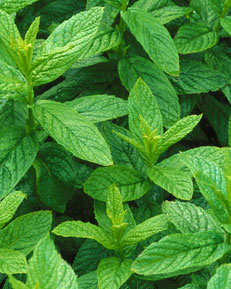
Photo © Steven Foster
Introduction
Mentha spicata is a perennial that grows 2 to 3 feet high.1 The stems produce ovate, wrinkled leaves in pairs. From mid-summer through autumn, white to pink cylindrical flowers are produced at the ends of the stems.2 The widely used spearmint oil is produced by steam distillation of the leaves.3 History and Cultural Significance
The spearmint plant originated in the Mediterranean region.1 The genus name Mentha comes from Roman mythology. According to legend, Prosperine killed a nymph named Menthe because of a love affair between Menthe and Prosperine’s husband, Pluto. Pluto resurrected Menthe into the form of the fragrant plant we know today. Greeks used mint to scent their bath water and also as a perfume. It also is mentioned in the Bible as a portion of a tithe by the Pharisees. It is widely accepted that the Pilgrims brought spearmint to North America.1 The modern name spearmint was derived from the leaves of the plant, which are spear-shaped.4 Of interesting note, the town of Mentha, Michigan was named after the plant and grows various mints as one of its principal industries.3 Spearmint is most commonly utilized for its scent or flavor in various internal and external products. The oil is used to flavor jellies, sauces, chewing gum, candy, iced tea, mouthwashes, toothpastes and breath mints.3 It is also used as a scent in perfumes.1 Though not quite as potent (and therefore less commonly used) as peppermint, M. spicata has been used to soothe indigestion, and other GI discomfort.1,2,3 The main constituent of the spearmint oil, called carvone, is reputed to have antiseptic properties.5 Modern Research
Most of the studies done on spearmint are laboratory or animal trials. One recent human study showed that chewing spearmint gum while studying has positive effects upon memory.6 There are currently no studies on the external use of spearmint. Future Outlook
The United States, India and China are the world’s largest commercial manufacturers of spearmint oil, accounting for nearly the entire global production. A small portion of the commercial product is produced in other parts of North and South America and in Japan. The annual production of spearmint oil is more than 1,600 tons, with the USA responsible for about 70%. One of the problem markets is China, where farmers are switching to other crops. It is currently unknown if this will affect the ability of the industry to meet demand.7 References
1 Grieve M. A Modern Herbal. Vol. 2. New York: Dover Books; 1971. 2 Bown D. The Herb Society of America New Encyclopedia of Herbs and Their Uses. London: Dorling Kindersley Ltd.; 2001. 3 Onstad D. Whole Foods Companion: A Guide for Adventurous Cooks, Curious Shoppers & Lovers of Natural Foods. White River Junction, VT: Chelsea Green Publishing Company; 1996. 4 Spearmint. Wikipedia Encyclopedia web site. Available at: http://en.wikipedia.org/wiki/Spearmint. Accessed on December 14, 2005. 5 Hoffmann D. Medical Herbalism: The Science and Practice of Herbal Medicine. Rochester, VT: Healing Arts Press; 2003. 6 Baker J, Bezance J, Zellaby E, et al. Chewing gum can produce context-dependent effects upon memory. Appetite. October 2004;43(2):207-10. 7 Stevens T. The Changing World of Mint, Bletchley Park. The British Society of Flavourists web site. February 2005. Available at: http://www.bsf.org.uk/doc/NV_2005-2_may.pdf. Accessed on December 14, 2005.
|